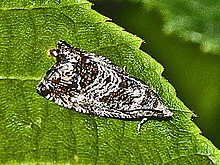Cydia fagiglandana
| Beech moth | |
|---|---|

| |
| Adult of Cydia fagiglandana | |
| Scientific classification | |
| Domain: | Eukaryota |
| Kingdom: | Animalia |
| Phylum: | Arthropoda |
| Class: | Insecta |
| Order: | Lepidoptera |
| Family: | Tortricidae |
| Genus: | Cydia |
| Species: | C. fagiglandana |
| Binomial name | |
| Cydia fagiglandana (Zeller, 1841) | |
| Synonyms | |
Cydia fagiglandana, the beech moth, is a moth of the family Tortricidae.
Distribution and habitat
This species is present in most of Europe. [3] These moths mainly occur in beech woodland.[4]
Description

Cydia fagiglandana can reach a wingspan of 12–16 mm.[4] The forewings are brown-black irrorated with whitish, crossed by pairs of fine dark brown stripes. The basal patch is slightly darker, the edge sharply angulated. There are two leaden-metallic streaks from costa posteriorly and a large darker coppery-tinged terminal patch hardly reaching costa. The ocellus within this patch is edged with leaden-metallic, enclosing some blackish marks. The hindwings are fuscous. The larvae are light yellowish or whitish, longitudinally clouded with orange; spots orange; head pale brownish; plate of 2 pale ochreous.[5] This species is rather similar to Cydia splendana.[4]
Biology
The moth flies from April to September depending on the location.[4] They are active in the evening. The larvae feed sometimes on oak (Quercus ilex, Quercus robur),[6] but usually on beech nuts (Fagus sylvatica).[4] The larval stage may last for two years. Pupation usually occurs in a cocoon spun in the soil or in rotten wood.[7] The first adults emerge in late spring.
References
- ^ Biolib
- ^ GBIF
- ^ Fauna Europaea
- ^ a b c d e UK Moths
- ^ Meyrick, E., 1895 A Handbook of British Lepidoptera MacMillan, London pdf
 This article incorporates text from this source, which is in the public domain. Keys and description
This article incorporates text from this source, which is in the public domain. Keys and description
- ^ Microlepidoptera.nl (in Dutch)
- ^ Catalogue of the Lepidoptera of Belgium
External links
